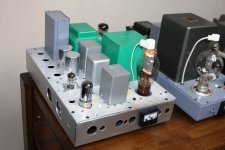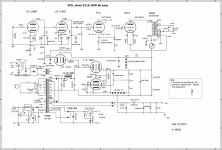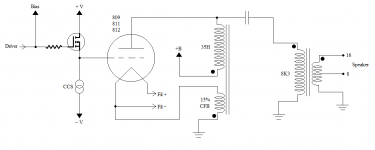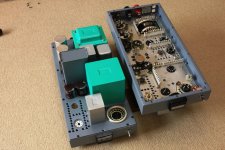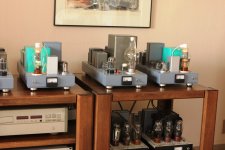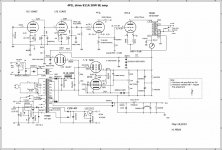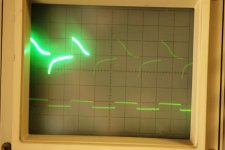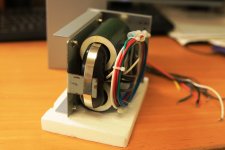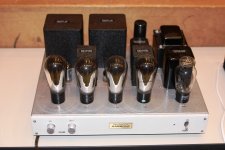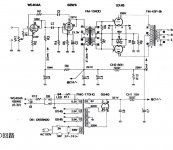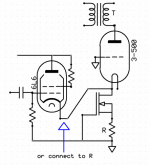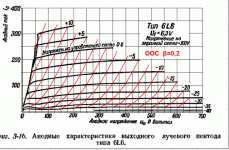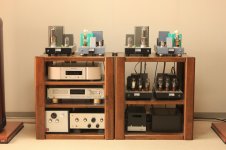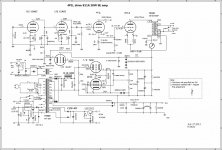I am grad to know that you are interested in my 811A amplifier.
Regarding to your idea of 6080, there are some negative points namely at less amplification factor and lower transconductance(gm). Frankly, I would not recommend the said 6080 for CF+CCS application.
Secondary, there is no availability in the market having the third winding coil for the cathode negative feedback.
In short, you must modify the circuit in accordance to your OPT in hand.
Happy new year to you and best regards
Hiro
Regarding to your idea of 6080, there are some negative points namely at less amplification factor and lower transconductance(gm). Frankly, I would not recommend the said 6080 for CF+CCS application.
Secondary, there is no availability in the market having the third winding coil for the cathode negative feedback.
In short, you must modify the circuit in accordance to your OPT in hand.
Happy new year to you and best regards
Hiro
Revised 811A SE amp employing 4P1L driver
I re-built (trial) the third version of 811ASE amp employing 4P1L choke-loaded cathode follower (capable to drive even to minus region without minus DC) replacing conventional regulator tube driving (CF+CCS) method, and have got excellent result in the sound quality as well as its measured figures. 4P1L is running under almost maximum dissipation level. I hear the sound is quiet and better in bass response while keeping brilliant high range. Maximum output is 20W which is the same as the predecessor. The distortion level is considerably lower; 1.6% at 20W, 0.68% at 10W and 0.032% at 1W. The frequency response measured is; -1.0 db at 20Hz and -3.1 db at 100 KHz and the dumping factor is 1.9.
Additionally, I tried to separate PSU; a) for output power stage, b) for voltage amp stages by employing a 6AS7 (twin triode: one for output power stage and the other for voltage amp stages) as for HT regulators. Expected benefits are: a) lower impedance, b) separation between output stage and voltage amp stages and c) capable for gradual start up avoiding extra high voltage (friendly to capacitors).
Attached are 1) photo of the 811A SE amp (third version trial) and its schematic.
I re-built (trial) the third version of 811ASE amp employing 4P1L choke-loaded cathode follower (capable to drive even to minus region without minus DC) replacing conventional regulator tube driving (CF+CCS) method, and have got excellent result in the sound quality as well as its measured figures. 4P1L is running under almost maximum dissipation level. I hear the sound is quiet and better in bass response while keeping brilliant high range. Maximum output is 20W which is the same as the predecessor. The distortion level is considerably lower; 1.6% at 20W, 0.68% at 10W and 0.032% at 1W. The frequency response measured is; -1.0 db at 20Hz and -3.1 db at 100 KHz and the dumping factor is 1.9.
Additionally, I tried to separate PSU; a) for output power stage, b) for voltage amp stages by employing a 6AS7 (twin triode: one for output power stage and the other for voltage amp stages) as for HT regulators. Expected benefits are: a) lower impedance, b) separation between output stage and voltage amp stages and c) capable for gradual start up avoiding extra high voltage (friendly to capacitors).
Attached are 1) photo of the 811A SE amp (third version trial) and its schematic.
Attachments
I've worked up sort of a "universal" output stage for Class A2 tubes. It works very well and lends itself to experimentation. It’s very flexible because of the parafeed design. It’s easy to change load lines by swapping out the OPT. The plate choke with cathode feedback stays in the circuit. One of the more interesting things I found while refining this idea is most transformer winders freak out when you ask for a plate choke with a 15% CFB winding. However, they are more than happy to wind you a 6.6K to 150 ohm OPT - LOL! They are one in the same.
Attachments
The third version of my 811A SE amp
The third version of my 811A SE amp (4P1L choke-loaded cathode follower drive) had been working from the beginning of this year was finally accomplished.
The sound is warm and mild. As the distortion level (THD) is so low that I can listen to any kind of music in peace.
Attached are: just before wire, work in listening room and the latest schematic.
The third version of my 811A SE amp (4P1L choke-loaded cathode follower drive) had been working from the beginning of this year was finally accomplished.
The sound is warm and mild. As the distortion level (THD) is so low that I can listen to any kind of music in peace.
Attached are: just before wire, work in listening room and the latest schematic.
Attachments
Nice amp Michi. I also read your comments about Softone and I think that poor performance at low frequency is very much related to core type. These R and amorphous cores look good on paper and on the bench but cannot quite match the sound of HiB C-cores, in my opinion. I think R core and amouphous cores perfom better in push-pull operation. I also prefer best grade EI to amorphous.....
Thanks 45.
Last Sunday I had a chance to hear 45pp amp employing amorphous OPT (FM-45P-8K) and inter-stage transformer (1040D).
The sound was fantastic and felt very easy to sleep!
BTW, My Softon RW-40-5 OPT was probably special case. I suspect that the core might be touched (no gap) due to production failure.
A friend of mine built an 811A SE amp adopting Softon RW-40-5 works nicely.
Last Sunday I had a chance to hear 45pp amp employing amorphous OPT (FM-45P-8K) and inter-stage transformer (1040D).
The sound was fantastic and felt very easy to sleep!
BTW, My Softon RW-40-5 OPT was probably special case. I suspect that the core might be touched (no gap) due to production failure.
A friend of mine built an 811A SE amp adopting Softon RW-40-5 works nicely.
Attachments
To H. Michi
I did your first circuit. In the driver I set a pair of 6S19P (I think that the pair 6R-A3 from NEC will be even better). The anode current of the first stages in the 6SN7 I did more, I think it's more linear mode. The rectifier I did on 6D22S.
The sound is great.
I did your first circuit. In the driver I set a pair of 6S19P (I think that the pair 6R-A3 from NEC will be even better). The anode current of the first stages in the 6SN7 I did more, I think it's more linear mode. The rectifier I did on 6D22S.
The sound is great.
Thanks 45.
Last Sunday I had a chance to hear 45pp amp employing amorphous OPT (FM-45P-8K) and inter-stage transformer (1040D).
The sound was fantastic and felt very easy to sleep!
BTW, My Softon RW-40-5 OPT was probably special case. I suspect that the core might be touched (no gap) due to production failure.
A friend of mine built an 811A SE amp adopting Softon RW-40-5 works nicely.
Yes, the gap failure could be the case. These cores are a bit more sensitive to gap spacing as well.
I believe they are more suited for push-pull because when you need a good gap for SE operation their permeability drops more in comparison to HiB and because of lower core loss there is more difference in terms of open secondary characteristics between low and mid frequencies. This is reflected in the the effective load they present to the vacuum tubes when loaded with the speakers of course.
Regarding the 45 push-pull, this is my favourite amplifier. I have tried many solutions over the years for the driver and I prefer the DC coupled cathode follower with 6SN7 working at about 9-10 mA. This way I get full power in class A with very low distortion and very smooth behaviour when entering positive grid.
I want to try 8K plate-to-plate instead of the classical 5K. Maximum power will be lower than 12W (with approx. 3% THD) but I feel I will get even better distortion figure up to 7-8W power output, in particular at very low power. I am thinking to buy the Hasimoto HW-40-8. What do you think about this transformer?
I agree with you amouphous cores OPT perform better in PP.
For SE OPT , The core volume should be as bigger as possible.
I have no experience with PP OPT and Hashimoto OPTs.
But I am sure Tamura, Tango and Hashimoto they have long experience for production of various transformers.
BTW, I was surprised to hear you have snow in UK now.
For SE OPT , The core volume should be as bigger as possible.
I have no experience with PP OPT and Hashimoto OPTs.
But I am sure Tamura, Tango and Hashimoto they have long experience for production of various transformers.
BTW, I was surprised to hear you have snow in UK now.
Attachments
Hi H. Michi,
You bias 811A is obtained by the voltage drop across choke.
Do you have a problem with setting the plate current 811A?
And 5998 is no worse than the driver 300b for 300b.
Yes, the choke is TC-60-35W(60H,35mA,DCR=740ohm) and We only have to adjust the plate voltage of 4P1L.
I made it by putting in 1 mu of input capacitor and 100 ohm of series resistor.
OK, 5998A is very good tube for driving 838 and 100TH.
hi µ triodes are connected with grounded grid in rf amps. why not use it ?
this way the driver is working always to constant type of load
connecting driver to R it will have even higher gain
The whole point of the cathode winding.
On one of the Russian-language sites is a separate issue on cathode windings ÔÎÐÓÌ ËÞÁÈÒÅËÅÉ ËÀÌÏÎÂÎÃÎ ÇÂÓÊÀ. I took out a diagram conversion pentode volt-current characteristics to triode volt-current characteristics by the introduction of the cathode winding.
Attachments
BTW, I was surprised to hear you have snow in UK now.
Yes, that's really funny weather!
In my county it is fine, temperature is acceptable and we have sunny spells these days.
hi µ triodes are connected with grounded grid in rf amps. why not use it ?
It raises the output impedance (of the output stage) to huge readings and the circuit can not be anymore used without GNFB.
But if plenty of GNFB is acceptable, then it is OK.
811A SE amp driven by 4P1L choke loaded cathode follower
811A SE amp (20W) driven by 4P1L choke loaded cathode follower
Almost two months past by since I replaced to 4P1L cathode follower drive from a decade used regulator tube drive to 811A SE amp, I have come to a certain feeling at improving THD level and father natural sounding.
However there is a miner concern of exceeding max. plate dissipation of 4P1L.
The maximum plate dissipation of 4P1L in triode connection would be around 8W.
Now the dissipation of 4P1L is 243V x 0.036mA=8.7W
So far it is working nicely.
The circuit description
1. Cathode choke is a Tango TC60-35W (60H/35mA, DCR: 730 ohm) which is originally designed for the plate choke for the small power tubes.
2 The operating point of the 811A:
Plate voltage: 600V, Grid bias: +17.5V, Plate current: 75~80mA,
Load impedance of OPT: 5.9K ohm, Max. driving voltage:45Vrms at 20W output. The grid current for the 811A is 12mA at resting condition, so that actual current through the choke is 36-12=24mA.
3 Consequently the grid bias for the 811A become: V=0.024x730=+17.5V
4 To obtain above condition, the fine adjustment of 4P1l plate voltage is necessary.
5 OPT is Tango XE60-5SNF: 30W (40Hz), primary impedance of 5K ohm with 36 ohm 3rd winding. Cathode NFB is 8.2dB(measured)
6 The 30 sec delay relay installed in the filament circuit of the 4P1L is to avoid rush current occurred to 811A during start-up time.
811A SE amp (20W) driven by 4P1L choke loaded cathode follower
Almost two months past by since I replaced to 4P1L cathode follower drive from a decade used regulator tube drive to 811A SE amp, I have come to a certain feeling at improving THD level and father natural sounding.
However there is a miner concern of exceeding max. plate dissipation of 4P1L.
The maximum plate dissipation of 4P1L in triode connection would be around 8W.
Now the dissipation of 4P1L is 243V x 0.036mA=8.7W
So far it is working nicely.
The circuit description
1. Cathode choke is a Tango TC60-35W (60H/35mA, DCR: 730 ohm) which is originally designed for the plate choke for the small power tubes.
2 The operating point of the 811A:
Plate voltage: 600V, Grid bias: +17.5V, Plate current: 75~80mA,
Load impedance of OPT: 5.9K ohm, Max. driving voltage:45Vrms at 20W output. The grid current for the 811A is 12mA at resting condition, so that actual current through the choke is 36-12=24mA.
3 Consequently the grid bias for the 811A become: V=0.024x730=+17.5V
4 To obtain above condition, the fine adjustment of 4P1l plate voltage is necessary.
5 OPT is Tango XE60-5SNF: 30W (40Hz), primary impedance of 5K ohm with 36 ohm 3rd winding. Cathode NFB is 8.2dB(measured)
6 The 30 sec delay relay installed in the filament circuit of the 4P1L is to avoid rush current occurred to 811A during start-up time.
Attachments
Almost two months past by since I replaced to 4P1L cathode follower drive from a decade used regulator tube drive to 811A SE amp, I have come to a certain feeling at improving THD level and father natural sounding.
However there is a miner concern of exceeding max. plate dissipation of 4P1L.
The maximum plate dissipation of 4P1L in triode connection would be around 8W.
Now the dissipation of 4P1L is 243V x 0.036mA=8.7W
Nice design
I'm concerning matching on impedance. Can you tell me how much are Zout of 4P1L and Zin of 811 ?
- Status
- This old topic is closed. If you want to reopen this topic, contact a moderator using the "Report Post" button.
- Home
- Amplifiers
- Tubes / Valves
- 811a Class A2
